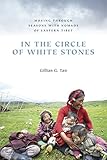In the circle of white stones : moving through seasons with nomads of eastern Tibet / Gillian G. Tan.
Material type: TextSeries: Studies on ethnic groups in ChinaPublisher: Seattle : University of Washington Press, [2017]Copyright date: ©2017Description: 1 online resource (xxiv, 147 pages) : illustrations, mapsContent type:
TextSeries: Studies on ethnic groups in ChinaPublisher: Seattle : University of Washington Press, [2017]Copyright date: ©2017Description: 1 online resource (xxiv, 147 pages) : illustrations, mapsContent type: - 9780295999494
- 0295999497
- Tan, Gillian G. -- Travel -- Tibet, Plateau of
- Tan, Gillian G. -- Travel -- Tibet, Plateau of
- Tan, Gillian G
- Tibetan Plateau -- Social life and customs
- Nomads -- Tibetan Plateau -- Social life and customs
- Seasons -- Tibetan Plateau
- Pastoral systems -- Tibetan Plateau
- Buddhists -- Tibetan Plateau -- Social life and customs
- Tibetan Plateau -- Religious life and customs
- Tibetan Plateau -- Description and travel
- Ethnology -- Tibetan Plateau
- Tibetan Plateau -- Ethnic relations
- Tibet, Plateau du -- Mœurs et coutumes
- Nomades -- Tibet, Plateau du -- Mœurs et coutumes
- Saisons -- Tibet, Plateau du
- Pastoralisme -- Tibet, Plateau du
- Bouddhistes -- Tibet, Plateau du -- Mœurs et coutumes
- Tibet, Plateau du -- Vie religieuse
- Tibet, Plateau du -- Descriptions et voyages
- Ethnologie -- Tibet, Plateau du
- Tibet, Plateau du -- Relations interethniques
- SOCIAL SCIENCE -- Discrimination & Race Relations
- SOCIAL SCIENCE -- Minority Studies
- HISTORY -- Asia -- China
- Buddhists -- Social life and customs
- Ethnic relations
- Ethnology
- Manners and customs
- Nomads -- Social life and customs
- Pastoral systems
- Seasons
- Travel
- China -- Plateau of Tibet
- Nomade
- Tibet -- Ost
- 305.9/0691809515 23
- DS786 .T33 2017eb
- online - EBSCO
| Item type | Current library | Call number | URL | Status | Notes | Barcode | |
|---|---|---|---|---|---|---|---|
 eBook
eBook
|
Biblioteca "Angelicum" Pont. Univ. S.Tommaso d'Aquino Nuvola online | online - EBSCO (Browse shelf(Opens below)) | Online access | Not for loan (Accesso limitato) | Accesso per gli utenti autorizzati / Access for authorized users | (ebsco)1359148 |
"In this ethnographic narrative of subsistence on the Tibetan plateau, anthropologist Gillian Tan describes the life-worlds of Tibetan nomads in a region traditionally known as Kham. The people of Dora Karmo (Circle of White Stones) are pastoralists who move with their yaks from pasture to pasture and depend on the milk production of their herd for sustenance. Tan's story, based her on own experience of living through seasonal cycles with the people of Dora Karmo between 2006 and 2013, examines the community's powerful relationship with a Buddhist lama and their interactions with external agents of change. As Buddhists, they believe in the never-ending cycle of life and death through reincarnation. Death, then, is not regarded as permanent loss but as the opportunity for continual change. Portrayals of personal loss through natural causes and revenge feuds, as well as sky burials, illustrate how impermanence permeates daily life. These pastoralists have adapted since 1959 to conditions imposed by the Chinese state through a combination of acquiescence, strategy, and resistance. They have also started to participate in the markets of a rapidly modernizing China, and in projects of international development that originate outside their own belief systems and social structures. In showing how the people of Dora Karmo perceive their environment and dwell in their world, Tan calls on development agents to consider this different worldview before they initiate projects among and for nomads"--Provided by publisher
This narrative of subsistence on the Tibetan plateau describes the life-worlds of people in a region traditionally known as Kham who move with their yaks from pasture to pasture, depending on the milk production of their herd for sustenance. Gillian Tan's story, based on her own experience of living through seasonal cycles with the people of Dora Karmo between 2006 and 2013, examines the community's powerful relationship with a Buddhist lama and their interactions with external agents of change. In showing how they perceive their environment and dwell in their world, Tan conveys a spare beauty that honors the stillness and rhythms of nomadic life.
Includes bibliographical references and index.
Getting to Dora Karmo -- The house and the tent -- Life in the summer pasture -- A world of impermanence -- The Lama -- Leaving and arriving.
Print version record.


